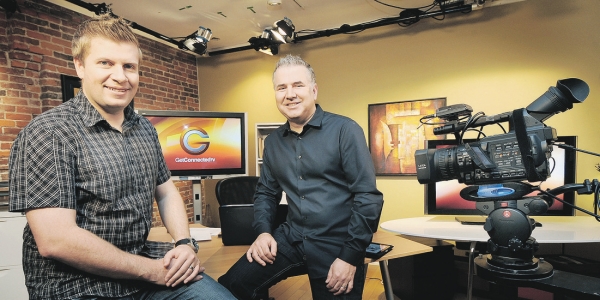The future of driving makes Bluetooth seem like the 21st century’s horse-drawn carriage
Andrew McCredie
Sun

AJ Vickery (left) and Mike Agerbo co-host the technology show GetConnected in their Vancouver studio. Photograph by: Wayne Leidenfrost, PNG / Vancouver Sun
If you think electric cars, hybrid engines and the hydrogen highway are the big news in the automotive world today, you are living in the clouds.
Which is somewhat ironic, as the clouds, more specifically, the “Cloud,” is where the most important technological leap in the car business is taking place. As any tech-geek worth their iPad will tell you, the Cloud, at least in a very broad sense, represents the wireless world and the community of devices that talk to each other.
For A.J. Vickery and Dave Agerbo, co-hosts of the technology show GetConnected, the coming five years marks a paradigm shift of sorts in the way we interact with our rides.
“What we’re seeing more and more of is connectivity, where everything in your home speaks to each other,” explains Agerbo on the Vancouver set of Get-Connected. “And in the next few years that will be the same for cars, with every new car having an Internet connection to transport real-time data.”
Calling vehicles, “the next battleground for operating systems,” Agerbo believes that once cars start talking to each other through the Cloud, the possibilities are endless.
“Just think about the radio in your car. Once you are tethered to the Internet, you have access to a hundred thousand Internet stations,” he continues, adding that unless satellite radio does some major evolution of its own very soon, the service will be dead. “Why would you pay a subscription when you’ll have an Internet-connected car and all those Internet stations?”
According to Vickery, Ford’s partnership with Microsoft on the SYNC system is leading the way for automakers worldwide, and with GM’s recent technology sharing agreement with Google, he predicts we’re just seeing the beginning of major automakers and technology providers joining forces.
“The (Google) Android is now going to be a big part of GM vehicles going forward, and expect to see Google working with other manufacturers,” Vickery says, adding that when GM’s well-established OnStar service is combined with the Google-based system, drivers will be able to plan their trip on their home computer using Google Maps, then use the OnStar system to “push” the information to their vehicle.
Both Vickery and Agerbo agree however, that the Ford system continues to lead the way for now.
Notes Agerbo: “The next big thing for the Ford SYNC system is built-in Wi-Fi hot spots where you tether your iPhone or BlackBerry to it to create a Internet link. The auto manufacturers that can build that in will have a distinct advantage over their competitors.”
Agerbo says that while the wildly popular Bluetooth interface is a big part of today’s tethering landscape in car, he’s not impressed with the user experience. “I still get lots of calls from people who have trouble connecting their devices.”
But Vickery notes that one of the best hands-free devices on the market is a Bluetooth accessory.
“The iLane is essentially a hands-free system that works like your phone, but the neat thing about it is that it reads your e-mails or text messages to you, and if you want to respond it will make a WAV file and e-mail that back to the person you are responding to.”
That, he says, is a great solution to the biggest distraction drivers currently face, texting while they drive.
“I still see it all the time, people texting while they drive, so these devices that read and record for us are a good response to that, so expect to see more of that.”
Vickery also says not all emerging technologies associated with cars are wireless based. “For example, one of the problems with electric cars is that they make no noise, so manufacturers have been putting speakers on the outside of the car to generate a motor sound,” he notes
Still, both agree that it will be the integration of the many on-board technologies that are currently available, such as backup cameras, GPS-based navigation systems and telemetry sensors, that will have the most profound impact on the way we drive.
“So for example, if you’re running low on gas, an onboard app will search out the nearest gas stations and bring them up on the navigation system without you even prompting it,” explains Agerbo, adding that the entire process will take place without any prompting from the driver.
Adds Vickery: “It won’t be hard to imagine driving down the road and seeing a heads-up display showing where Starbucks or gas stations are as you get near them.”
So get used to the fact we’ll all be driving in the Cloud soon.
– – –
GetConnected:
Top five essential apps for drivers
Google Maps
“There might be lots of new apps out there, but this one is still the best for finding places and businesses.”
Gas Buddy
“This is a community-based app that requires your participation. Each time you go to a gas station you enter the price of fuel using the app, and it in turn maps prices in a region that users can reference when looking for the cheapest fuel nearby. “
Trapster
“Again, a community-based app that requires you to enter locations of any speed traps you might see.”
My Nearest
“By far the best app for finding the nearest of any and every kind of business, from restaurants to liquor stores to ATMs to coffee shops.”
On-Star App
“Works with an On-Star subscription and lets you unlock your car and perform other remote functions using the Android phone.”
© Copyright (c) The Vancouver Sun

